A Study on the Impact of Training and Development on Omantel Employees
VerifiedAdded on 2023/01/23
|72
|14748
|99
Report
AI Summary
This report presents a comprehensive analysis of the impact of training and development on employee performance, specifically focusing on Omantel, a telecommunications company in Oman. The study employs a quantitative research design, collecting primary data through a survey questionnaire administered to 100 Omantel employees. The research investigates the significance of training and development, identifies factors affecting employee performance (including empowerment, organizational culture, and coaching), and examines the relationship between training and development and employee outcomes. Data analysis includes frequency distribution, correlation analysis, and regression analysis to determine the extent to which training and development influences employee performance. The findings reveal a positive correlation between training and development and organizational culture, coaching, and employee performance, with statistically significant results indicating a strong impact. The report concludes with recommendations for improving training and development programs within Omantel and suggests areas for future research.
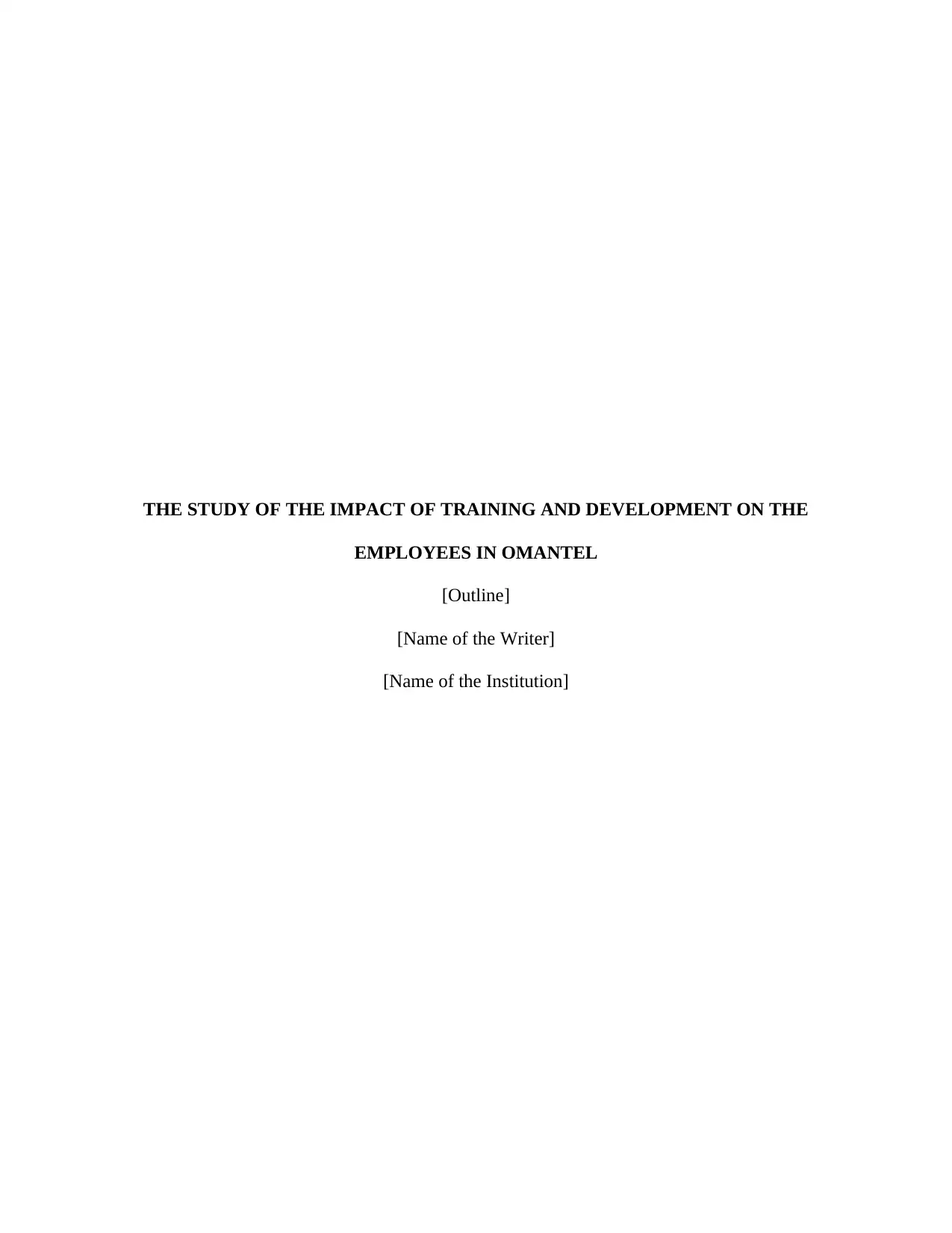
THE STUDY OF THE IMPACT OF TRAINING AND DEVELOPMENT ON THE
EMPLOYEES IN OMANTEL
[Outline]
[Name of the Writer]
[Name of the Institution]
EMPLOYEES IN OMANTEL
[Outline]
[Name of the Writer]
[Name of the Institution]
Paraphrase This Document
Need a fresh take? Get an instant paraphrase of this document with our AI Paraphraser
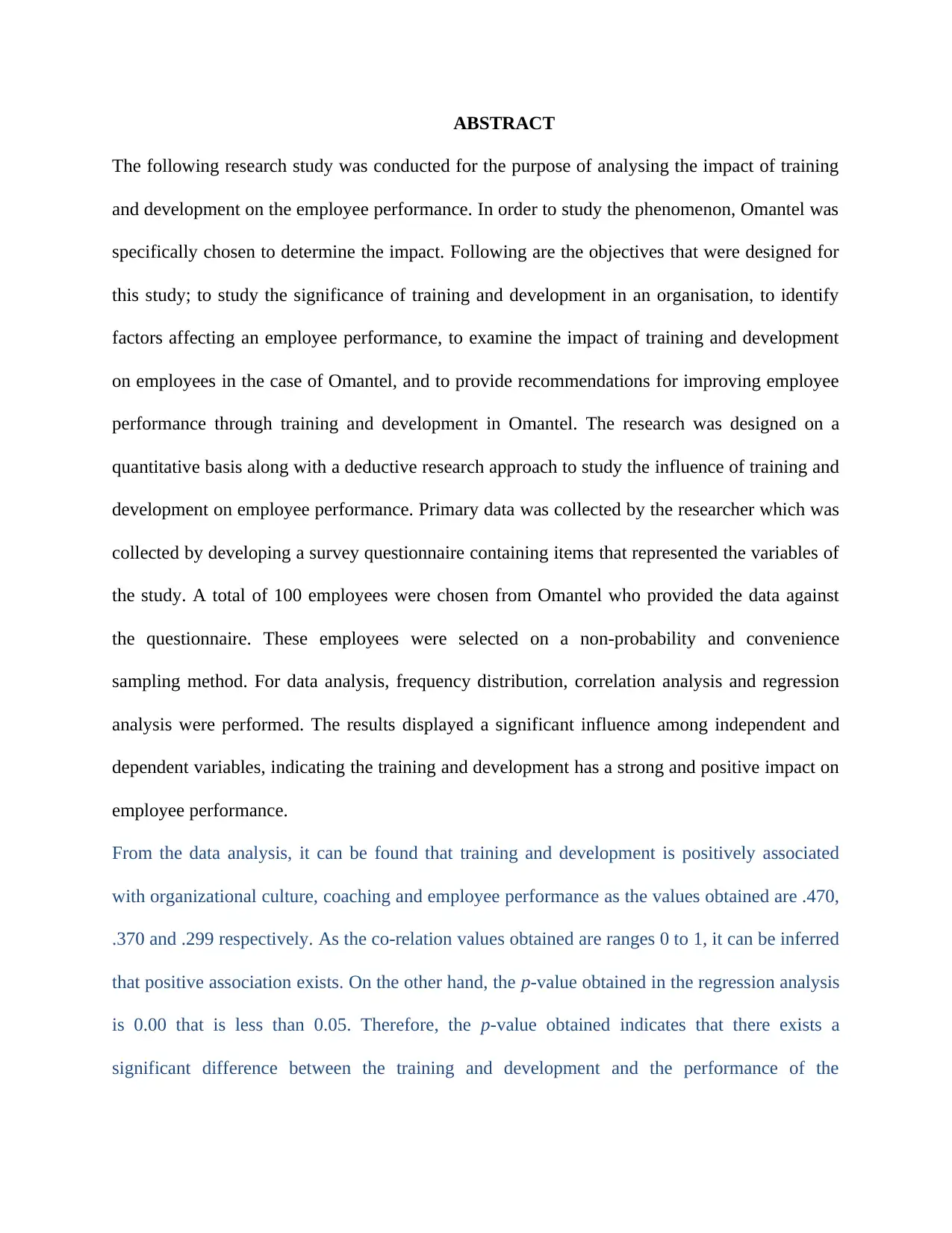
ABSTRACT
The following research study was conducted for the purpose of analysing the impact of training
and development on the employee performance. In order to study the phenomenon, Omantel was
specifically chosen to determine the impact. Following are the objectives that were designed for
this study; to study the significance of training and development in an organisation, to identify
factors affecting an employee performance, to examine the impact of training and development
on employees in the case of Omantel, and to provide recommendations for improving employee
performance through training and development in Omantel. The research was designed on a
quantitative basis along with a deductive research approach to study the influence of training and
development on employee performance. Primary data was collected by the researcher which was
collected by developing a survey questionnaire containing items that represented the variables of
the study. A total of 100 employees were chosen from Omantel who provided the data against
the questionnaire. These employees were selected on a non-probability and convenience
sampling method. For data analysis, frequency distribution, correlation analysis and regression
analysis were performed. The results displayed a significant influence among independent and
dependent variables, indicating the training and development has a strong and positive impact on
employee performance.
From the data analysis, it can be found that training and development is positively associated
with organizational culture, coaching and employee performance as the values obtained are .470,
.370 and .299 respectively. As the co-relation values obtained are ranges 0 to 1, it can be inferred
that positive association exists. On the other hand, the p-value obtained in the regression analysis
is 0.00 that is less than 0.05. Therefore, the p-value obtained indicates that there exists a
significant difference between the training and development and the performance of the
The following research study was conducted for the purpose of analysing the impact of training
and development on the employee performance. In order to study the phenomenon, Omantel was
specifically chosen to determine the impact. Following are the objectives that were designed for
this study; to study the significance of training and development in an organisation, to identify
factors affecting an employee performance, to examine the impact of training and development
on employees in the case of Omantel, and to provide recommendations for improving employee
performance through training and development in Omantel. The research was designed on a
quantitative basis along with a deductive research approach to study the influence of training and
development on employee performance. Primary data was collected by the researcher which was
collected by developing a survey questionnaire containing items that represented the variables of
the study. A total of 100 employees were chosen from Omantel who provided the data against
the questionnaire. These employees were selected on a non-probability and convenience
sampling method. For data analysis, frequency distribution, correlation analysis and regression
analysis were performed. The results displayed a significant influence among independent and
dependent variables, indicating the training and development has a strong and positive impact on
employee performance.
From the data analysis, it can be found that training and development is positively associated
with organizational culture, coaching and employee performance as the values obtained are .470,
.370 and .299 respectively. As the co-relation values obtained are ranges 0 to 1, it can be inferred
that positive association exists. On the other hand, the p-value obtained in the regression analysis
is 0.00 that is less than 0.05. Therefore, the p-value obtained indicates that there exists a
significant difference between the training and development and the performance of the

employees. The employees of Omantel agree that training and development have a significant
impact on their performance.
impact on their performance.
⊘ This is a preview!⊘
Do you want full access?
Subscribe today to unlock all pages.

Trusted by 1+ million students worldwide
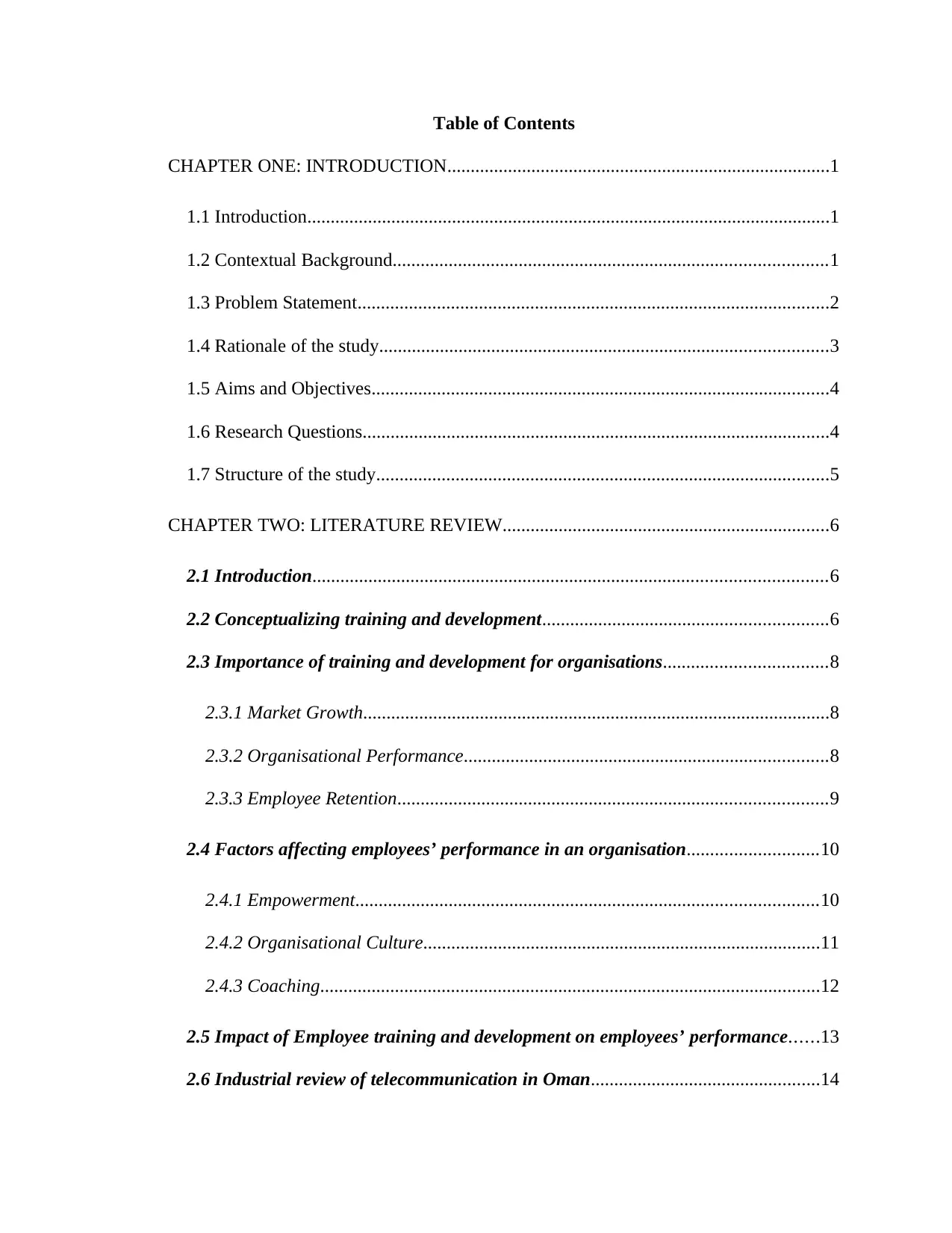
Table of Contents
CHAPTER ONE: INTRODUCTION..................................................................................1
1.1 Introduction................................................................................................................1
1.2 Contextual Background.............................................................................................1
1.3 Problem Statement.....................................................................................................2
1.4 Rationale of the study................................................................................................3
1.5 Aims and Objectives..................................................................................................4
1.6 Research Questions....................................................................................................4
1.7 Structure of the study.................................................................................................5
CHAPTER TWO: LITERATURE REVIEW......................................................................6
2.1 Introduction..............................................................................................................6
2.2 Conceptualizing training and development.............................................................6
2.3 Importance of training and development for organisations...................................8
2.3.1 Market Growth....................................................................................................8
2.3.2 Organisational Performance..............................................................................8
2.3.3 Employee Retention............................................................................................9
2.4 Factors affecting employees’ performance in an organisation............................10
2.4.1 Empowerment...................................................................................................10
2.4.2 Organisational Culture.....................................................................................11
2.4.3 Coaching...........................................................................................................12
2.5 Impact of Employee training and development on employees’ performance......13
2.6 Industrial review of telecommunication in Oman.................................................14
CHAPTER ONE: INTRODUCTION..................................................................................1
1.1 Introduction................................................................................................................1
1.2 Contextual Background.............................................................................................1
1.3 Problem Statement.....................................................................................................2
1.4 Rationale of the study................................................................................................3
1.5 Aims and Objectives..................................................................................................4
1.6 Research Questions....................................................................................................4
1.7 Structure of the study.................................................................................................5
CHAPTER TWO: LITERATURE REVIEW......................................................................6
2.1 Introduction..............................................................................................................6
2.2 Conceptualizing training and development.............................................................6
2.3 Importance of training and development for organisations...................................8
2.3.1 Market Growth....................................................................................................8
2.3.2 Organisational Performance..............................................................................8
2.3.3 Employee Retention............................................................................................9
2.4 Factors affecting employees’ performance in an organisation............................10
2.4.1 Empowerment...................................................................................................10
2.4.2 Organisational Culture.....................................................................................11
2.4.3 Coaching...........................................................................................................12
2.5 Impact of Employee training and development on employees’ performance......13
2.6 Industrial review of telecommunication in Oman.................................................14
Paraphrase This Document
Need a fresh take? Get an instant paraphrase of this document with our AI Paraphraser
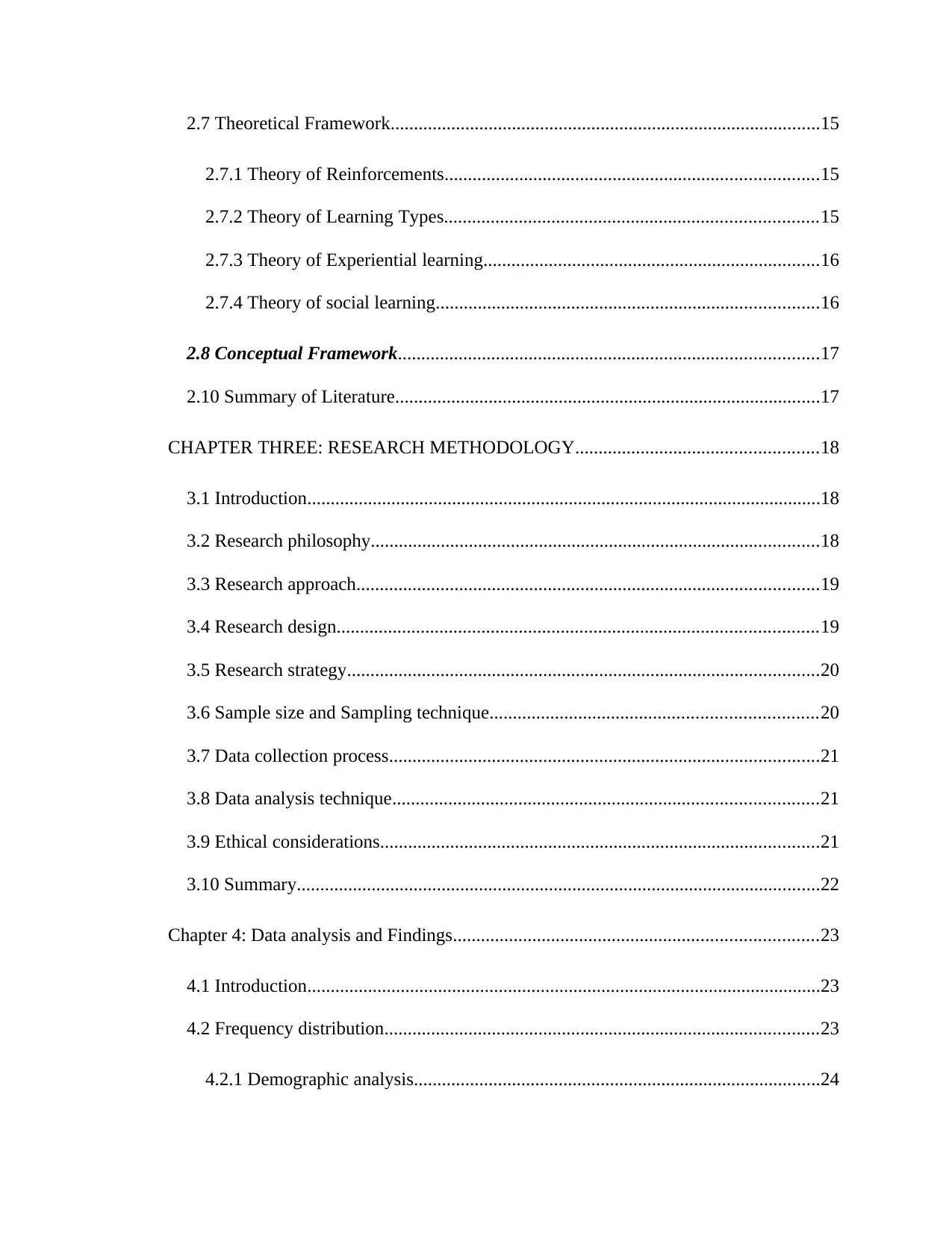
2.7 Theoretical Framework............................................................................................15
2.7.1 Theory of Reinforcements................................................................................15
2.7.2 Theory of Learning Types................................................................................15
2.7.3 Theory of Experiential learning........................................................................16
2.7.4 Theory of social learning..................................................................................16
2.8 Conceptual Framework..........................................................................................17
2.10 Summary of Literature...........................................................................................17
CHAPTER THREE: RESEARCH METHODOLOGY....................................................18
3.1 Introduction..............................................................................................................18
3.2 Research philosophy................................................................................................18
3.3 Research approach...................................................................................................19
3.4 Research design.......................................................................................................19
3.5 Research strategy.....................................................................................................20
3.6 Sample size and Sampling technique......................................................................20
3.7 Data collection process............................................................................................21
3.8 Data analysis technique...........................................................................................21
3.9 Ethical considerations..............................................................................................21
3.10 Summary................................................................................................................22
Chapter 4: Data analysis and Findings..............................................................................23
4.1 Introduction..............................................................................................................23
4.2 Frequency distribution.............................................................................................23
4.2.1 Demographic analysis.......................................................................................24
2.7.1 Theory of Reinforcements................................................................................15
2.7.2 Theory of Learning Types................................................................................15
2.7.3 Theory of Experiential learning........................................................................16
2.7.4 Theory of social learning..................................................................................16
2.8 Conceptual Framework..........................................................................................17
2.10 Summary of Literature...........................................................................................17
CHAPTER THREE: RESEARCH METHODOLOGY....................................................18
3.1 Introduction..............................................................................................................18
3.2 Research philosophy................................................................................................18
3.3 Research approach...................................................................................................19
3.4 Research design.......................................................................................................19
3.5 Research strategy.....................................................................................................20
3.6 Sample size and Sampling technique......................................................................20
3.7 Data collection process............................................................................................21
3.8 Data analysis technique...........................................................................................21
3.9 Ethical considerations..............................................................................................21
3.10 Summary................................................................................................................22
Chapter 4: Data analysis and Findings..............................................................................23
4.1 Introduction..............................................................................................................23
4.2 Frequency distribution.............................................................................................23
4.2.1 Demographic analysis.......................................................................................24
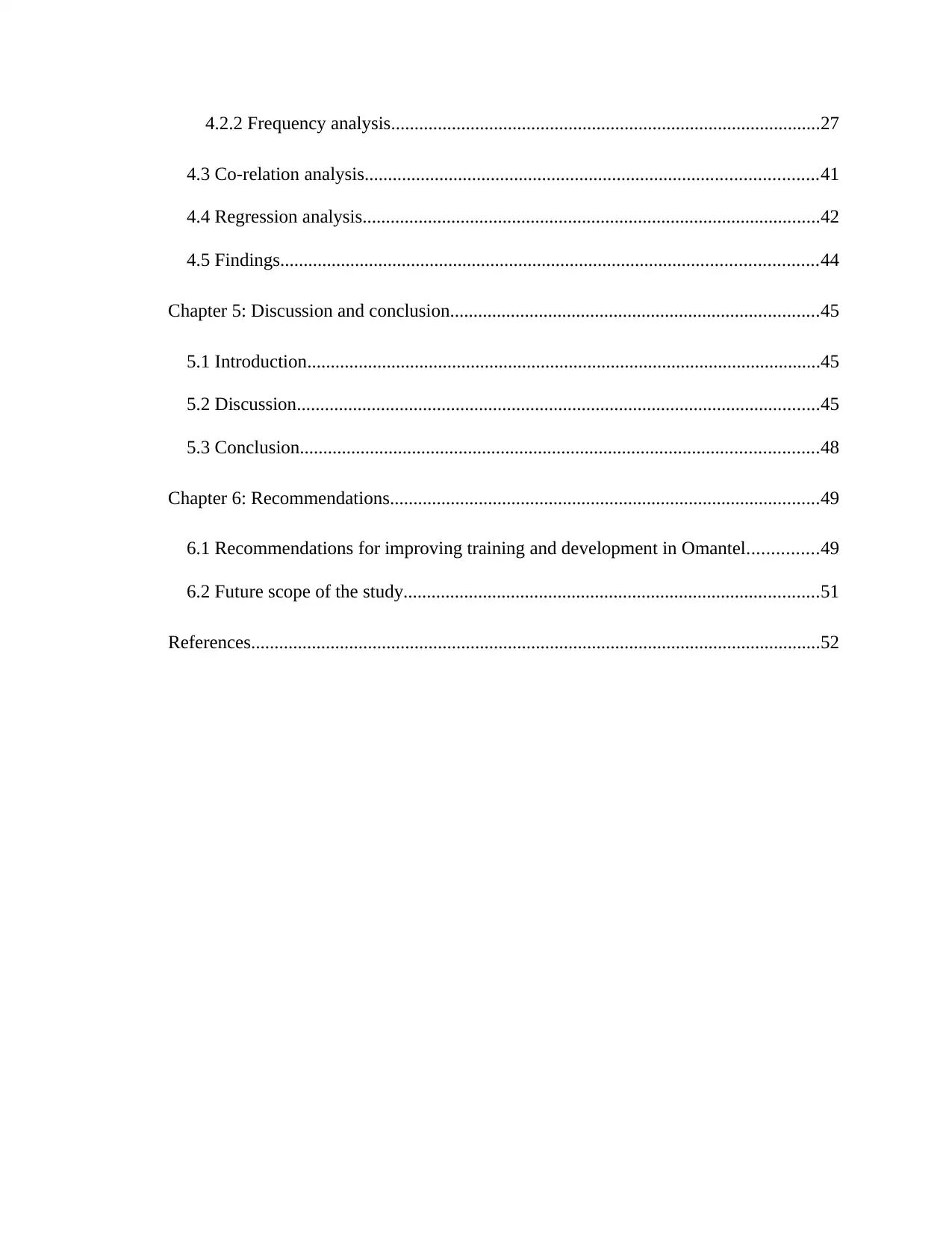
4.2.2 Frequency analysis............................................................................................27
4.3 Co-relation analysis.................................................................................................41
4.4 Regression analysis..................................................................................................42
4.5 Findings...................................................................................................................44
Chapter 5: Discussion and conclusion...............................................................................45
5.1 Introduction..............................................................................................................45
5.2 Discussion................................................................................................................45
5.3 Conclusion...............................................................................................................48
Chapter 6: Recommendations............................................................................................49
6.1 Recommendations for improving training and development in Omantel...............49
6.2 Future scope of the study.........................................................................................51
References..........................................................................................................................52
4.3 Co-relation analysis.................................................................................................41
4.4 Regression analysis..................................................................................................42
4.5 Findings...................................................................................................................44
Chapter 5: Discussion and conclusion...............................................................................45
5.1 Introduction..............................................................................................................45
5.2 Discussion................................................................................................................45
5.3 Conclusion...............................................................................................................48
Chapter 6: Recommendations............................................................................................49
6.1 Recommendations for improving training and development in Omantel...............49
6.2 Future scope of the study.........................................................................................51
References..........................................................................................................................52
⊘ This is a preview!⊘
Do you want full access?
Subscribe today to unlock all pages.

Trusted by 1+ million students worldwide
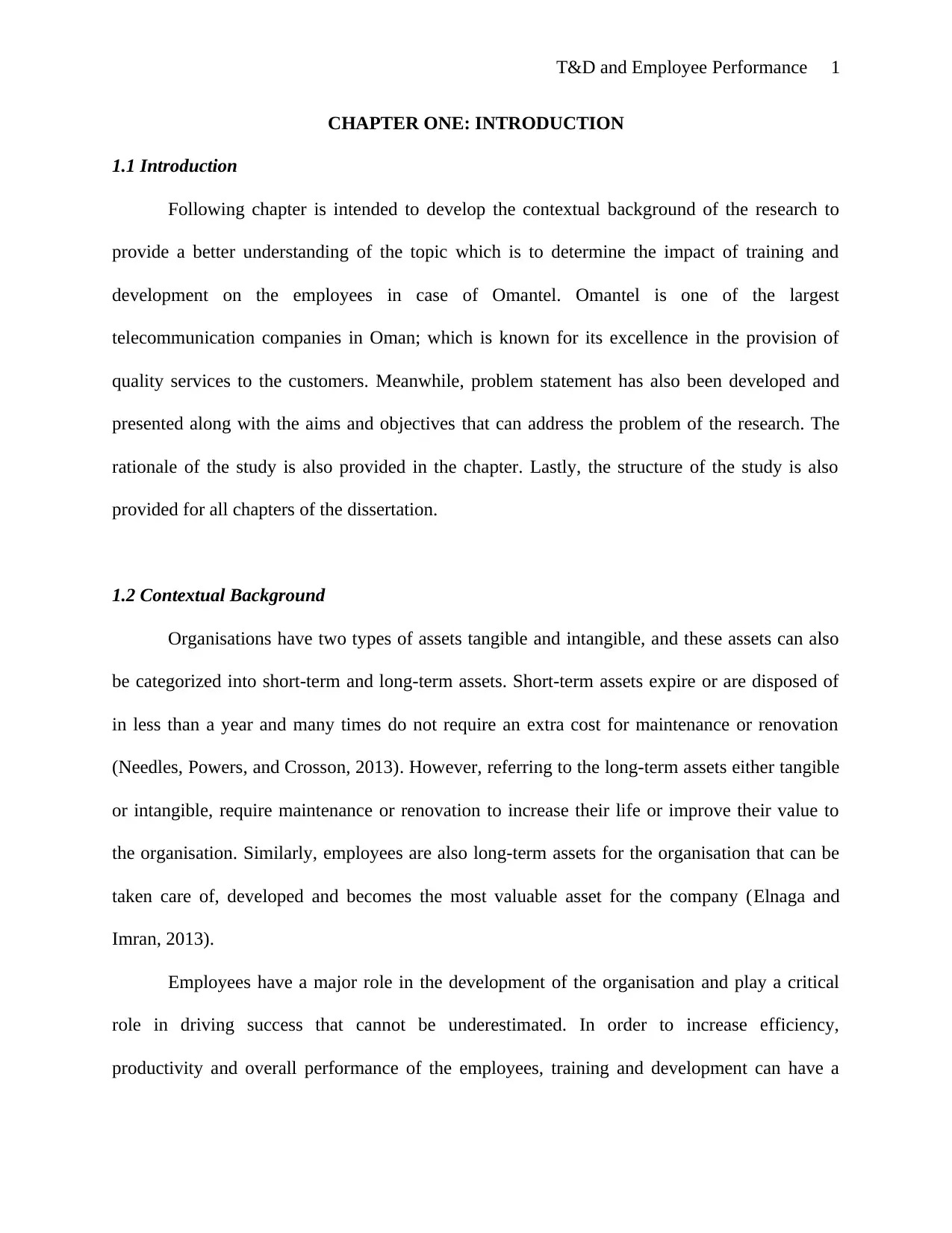
T&D and Employee Performance 1
CHAPTER ONE: INTRODUCTION
1.1 Introduction
Following chapter is intended to develop the contextual background of the research to
provide a better understanding of the topic which is to determine the impact of training and
development on the employees in case of Omantel. Omantel is one of the largest
telecommunication companies in Oman; which is known for its excellence in the provision of
quality services to the customers. Meanwhile, problem statement has also been developed and
presented along with the aims and objectives that can address the problem of the research. The
rationale of the study is also provided in the chapter. Lastly, the structure of the study is also
provided for all chapters of the dissertation.
1.2 Contextual Background
Organisations have two types of assets tangible and intangible, and these assets can also
be categorized into short-term and long-term assets. Short-term assets expire or are disposed of
in less than a year and many times do not require an extra cost for maintenance or renovation
(Needles, Powers, and Crosson, 2013). However, referring to the long-term assets either tangible
or intangible, require maintenance or renovation to increase their life or improve their value to
the organisation. Similarly, employees are also long-term assets for the organisation that can be
taken care of, developed and becomes the most valuable asset for the company (Elnaga and
Imran, 2013).
Employees have a major role in the development of the organisation and play a critical
role in driving success that cannot be underestimated. In order to increase efficiency,
productivity and overall performance of the employees, training and development can have a
CHAPTER ONE: INTRODUCTION
1.1 Introduction
Following chapter is intended to develop the contextual background of the research to
provide a better understanding of the topic which is to determine the impact of training and
development on the employees in case of Omantel. Omantel is one of the largest
telecommunication companies in Oman; which is known for its excellence in the provision of
quality services to the customers. Meanwhile, problem statement has also been developed and
presented along with the aims and objectives that can address the problem of the research. The
rationale of the study is also provided in the chapter. Lastly, the structure of the study is also
provided for all chapters of the dissertation.
1.2 Contextual Background
Organisations have two types of assets tangible and intangible, and these assets can also
be categorized into short-term and long-term assets. Short-term assets expire or are disposed of
in less than a year and many times do not require an extra cost for maintenance or renovation
(Needles, Powers, and Crosson, 2013). However, referring to the long-term assets either tangible
or intangible, require maintenance or renovation to increase their life or improve their value to
the organisation. Similarly, employees are also long-term assets for the organisation that can be
taken care of, developed and becomes the most valuable asset for the company (Elnaga and
Imran, 2013).
Employees have a major role in the development of the organisation and play a critical
role in driving success that cannot be underestimated. In order to increase efficiency,
productivity and overall performance of the employees, training and development can have a
Paraphrase This Document
Need a fresh take? Get an instant paraphrase of this document with our AI Paraphraser
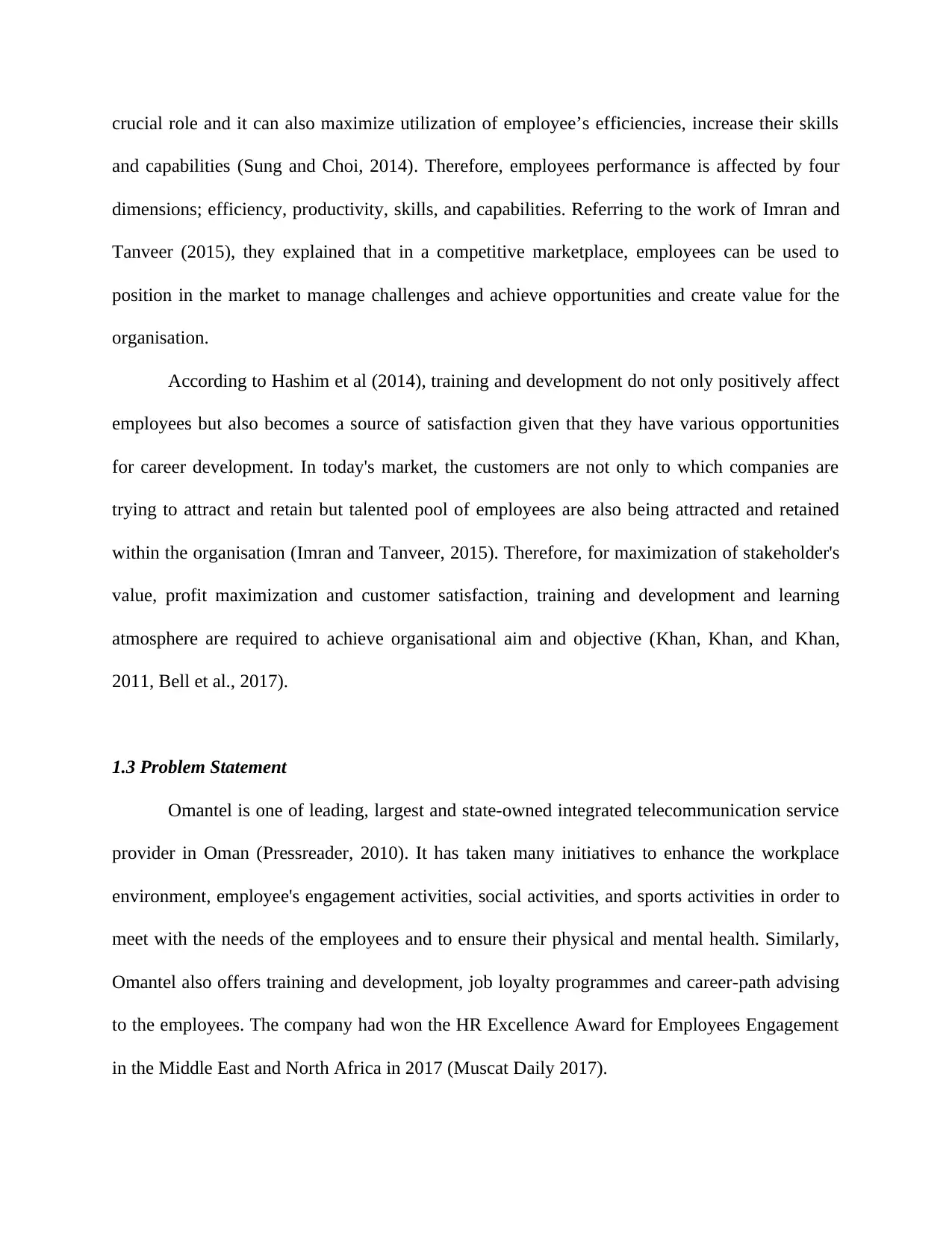
crucial role and it can also maximize utilization of employee’s efficiencies, increase their skills
and capabilities (Sung and Choi, 2014). Therefore, employees performance is affected by four
dimensions; efficiency, productivity, skills, and capabilities. Referring to the work of Imran and
Tanveer (2015), they explained that in a competitive marketplace, employees can be used to
position in the market to manage challenges and achieve opportunities and create value for the
organisation.
According to Hashim et al (2014), training and development do not only positively affect
employees but also becomes a source of satisfaction given that they have various opportunities
for career development. In today's market, the customers are not only to which companies are
trying to attract and retain but talented pool of employees are also being attracted and retained
within the organisation (Imran and Tanveer, 2015). Therefore, for maximization of stakeholder's
value, profit maximization and customer satisfaction, training and development and learning
atmosphere are required to achieve organisational aim and objective (Khan, Khan, and Khan,
2011, Bell et al., 2017).
1.3 Problem Statement
Omantel is one of leading, largest and state-owned integrated telecommunication service
provider in Oman (Pressreader, 2010). It has taken many initiatives to enhance the workplace
environment, employee's engagement activities, social activities, and sports activities in order to
meet with the needs of the employees and to ensure their physical and mental health. Similarly,
Omantel also offers training and development, job loyalty programmes and career-path advising
to the employees. The company had won the HR Excellence Award for Employees Engagement
in the Middle East and North Africa in 2017 (Muscat Daily 2017).
and capabilities (Sung and Choi, 2014). Therefore, employees performance is affected by four
dimensions; efficiency, productivity, skills, and capabilities. Referring to the work of Imran and
Tanveer (2015), they explained that in a competitive marketplace, employees can be used to
position in the market to manage challenges and achieve opportunities and create value for the
organisation.
According to Hashim et al (2014), training and development do not only positively affect
employees but also becomes a source of satisfaction given that they have various opportunities
for career development. In today's market, the customers are not only to which companies are
trying to attract and retain but talented pool of employees are also being attracted and retained
within the organisation (Imran and Tanveer, 2015). Therefore, for maximization of stakeholder's
value, profit maximization and customer satisfaction, training and development and learning
atmosphere are required to achieve organisational aim and objective (Khan, Khan, and Khan,
2011, Bell et al., 2017).
1.3 Problem Statement
Omantel is one of leading, largest and state-owned integrated telecommunication service
provider in Oman (Pressreader, 2010). It has taken many initiatives to enhance the workplace
environment, employee's engagement activities, social activities, and sports activities in order to
meet with the needs of the employees and to ensure their physical and mental health. Similarly,
Omantel also offers training and development, job loyalty programmes and career-path advising
to the employees. The company had won the HR Excellence Award for Employees Engagement
in the Middle East and North Africa in 2017 (Muscat Daily 2017).
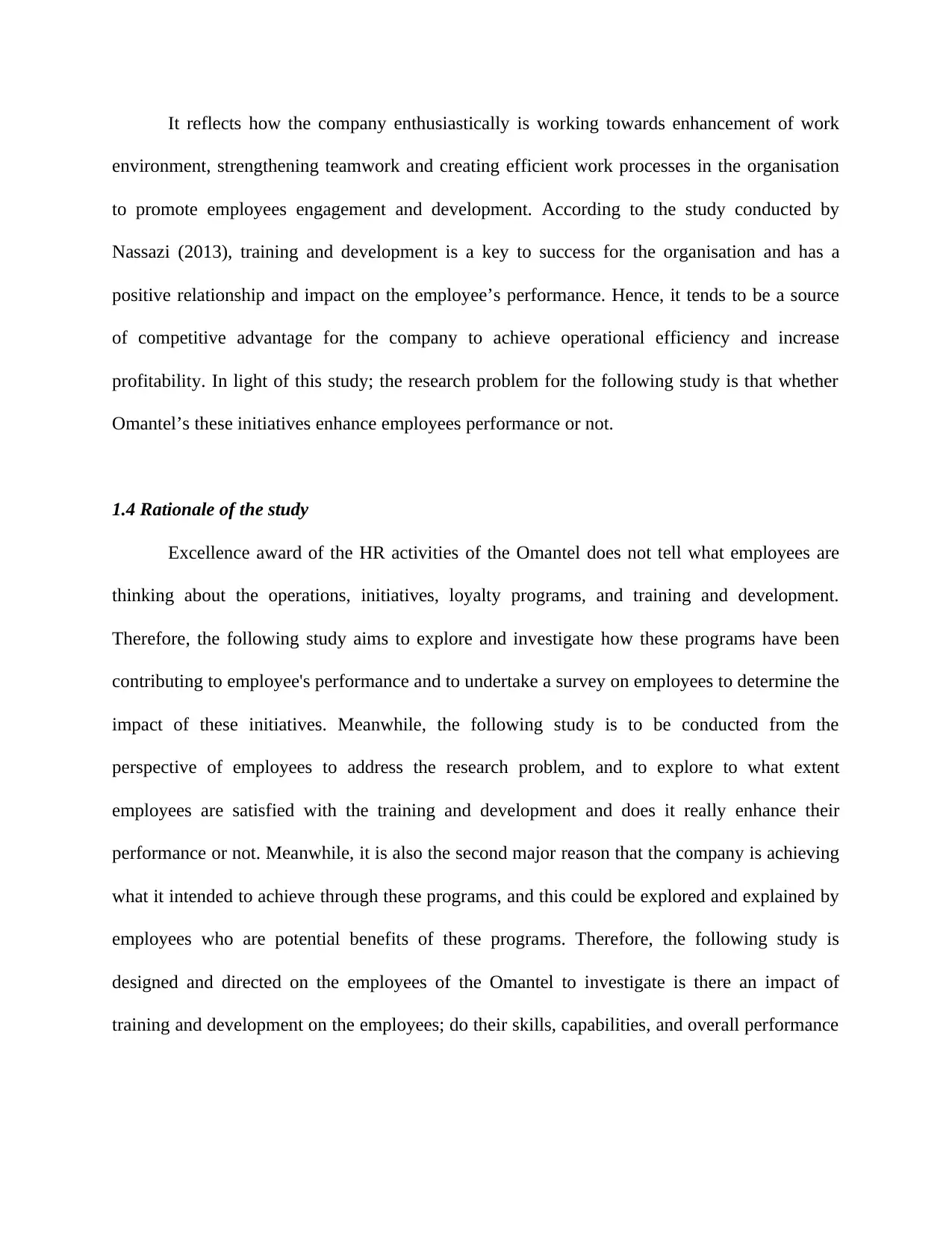
It reflects how the company enthusiastically is working towards enhancement of work
environment, strengthening teamwork and creating efficient work processes in the organisation
to promote employees engagement and development. According to the study conducted by
Nassazi (2013), training and development is a key to success for the organisation and has a
positive relationship and impact on the employee’s performance. Hence, it tends to be a source
of competitive advantage for the company to achieve operational efficiency and increase
profitability. In light of this study; the research problem for the following study is that whether
Omantel’s these initiatives enhance employees performance or not.
1.4 Rationale of the study
Excellence award of the HR activities of the Omantel does not tell what employees are
thinking about the operations, initiatives, loyalty programs, and training and development.
Therefore, the following study aims to explore and investigate how these programs have been
contributing to employee's performance and to undertake a survey on employees to determine the
impact of these initiatives. Meanwhile, the following study is to be conducted from the
perspective of employees to address the research problem, and to explore to what extent
employees are satisfied with the training and development and does it really enhance their
performance or not. Meanwhile, it is also the second major reason that the company is achieving
what it intended to achieve through these programs, and this could be explored and explained by
employees who are potential benefits of these programs. Therefore, the following study is
designed and directed on the employees of the Omantel to investigate is there an impact of
training and development on the employees; do their skills, capabilities, and overall performance
environment, strengthening teamwork and creating efficient work processes in the organisation
to promote employees engagement and development. According to the study conducted by
Nassazi (2013), training and development is a key to success for the organisation and has a
positive relationship and impact on the employee’s performance. Hence, it tends to be a source
of competitive advantage for the company to achieve operational efficiency and increase
profitability. In light of this study; the research problem for the following study is that whether
Omantel’s these initiatives enhance employees performance or not.
1.4 Rationale of the study
Excellence award of the HR activities of the Omantel does not tell what employees are
thinking about the operations, initiatives, loyalty programs, and training and development.
Therefore, the following study aims to explore and investigate how these programs have been
contributing to employee's performance and to undertake a survey on employees to determine the
impact of these initiatives. Meanwhile, the following study is to be conducted from the
perspective of employees to address the research problem, and to explore to what extent
employees are satisfied with the training and development and does it really enhance their
performance or not. Meanwhile, it is also the second major reason that the company is achieving
what it intended to achieve through these programs, and this could be explored and explained by
employees who are potential benefits of these programs. Therefore, the following study is
designed and directed on the employees of the Omantel to investigate is there an impact of
training and development on the employees; do their skills, capabilities, and overall performance
⊘ This is a preview!⊘
Do you want full access?
Subscribe today to unlock all pages.

Trusted by 1+ million students worldwide
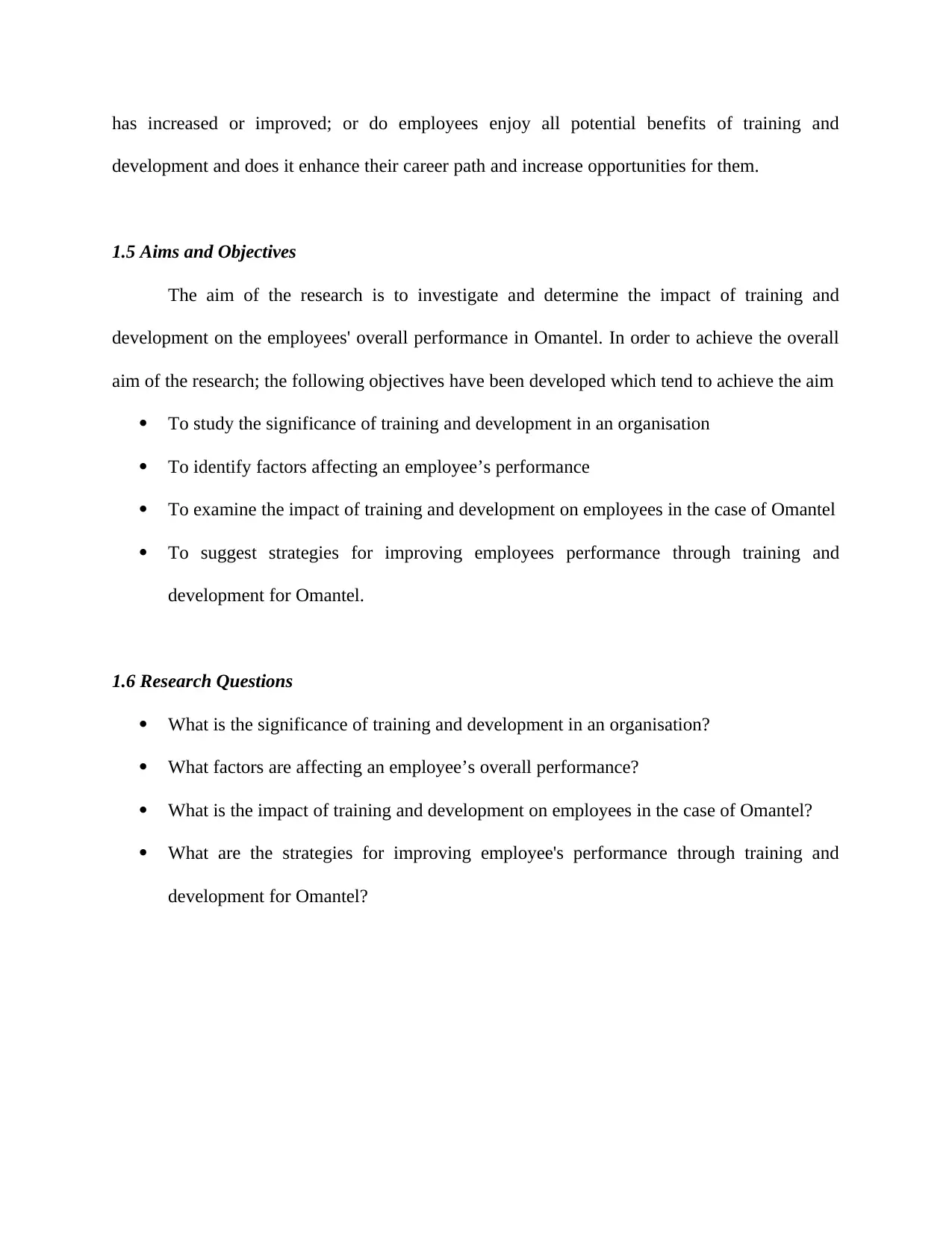
has increased or improved; or do employees enjoy all potential benefits of training and
development and does it enhance their career path and increase opportunities for them.
1.5 Aims and Objectives
The aim of the research is to investigate and determine the impact of training and
development on the employees' overall performance in Omantel. In order to achieve the overall
aim of the research; the following objectives have been developed which tend to achieve the aim
To study the significance of training and development in an organisation
To identify factors affecting an employee’s performance
To examine the impact of training and development on employees in the case of Omantel
To suggest strategies for improving employees performance through training and
development for Omantel.
1.6 Research Questions
What is the significance of training and development in an organisation?
What factors are affecting an employee’s overall performance?
What is the impact of training and development on employees in the case of Omantel?
What are the strategies for improving employee's performance through training and
development for Omantel?
development and does it enhance their career path and increase opportunities for them.
1.5 Aims and Objectives
The aim of the research is to investigate and determine the impact of training and
development on the employees' overall performance in Omantel. In order to achieve the overall
aim of the research; the following objectives have been developed which tend to achieve the aim
To study the significance of training and development in an organisation
To identify factors affecting an employee’s performance
To examine the impact of training and development on employees in the case of Omantel
To suggest strategies for improving employees performance through training and
development for Omantel.
1.6 Research Questions
What is the significance of training and development in an organisation?
What factors are affecting an employee’s overall performance?
What is the impact of training and development on employees in the case of Omantel?
What are the strategies for improving employee's performance through training and
development for Omantel?
Paraphrase This Document
Need a fresh take? Get an instant paraphrase of this document with our AI Paraphraser
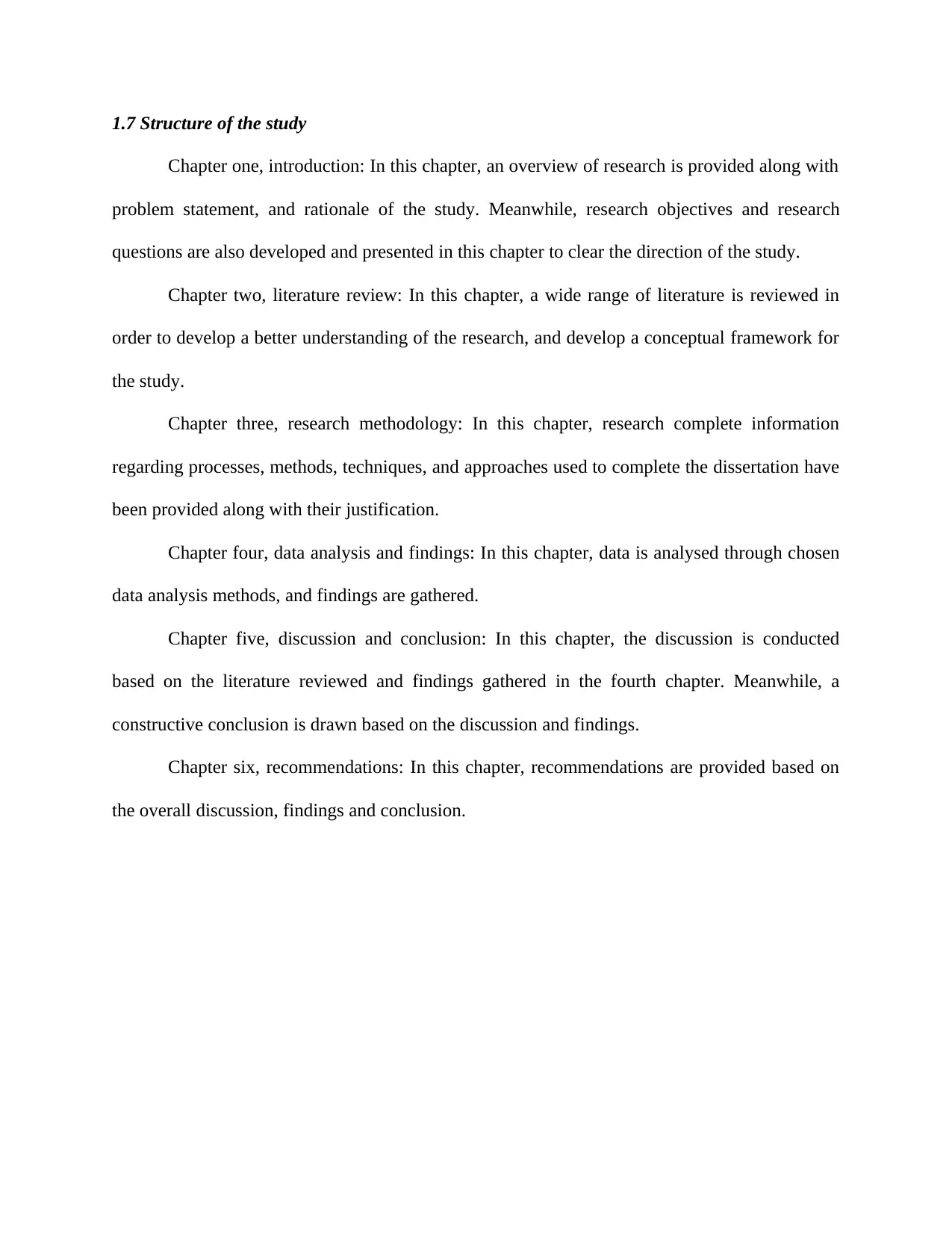
1.7 Structure of the study
Chapter one, introduction: In this chapter, an overview of research is provided along with
problem statement, and rationale of the study. Meanwhile, research objectives and research
questions are also developed and presented in this chapter to clear the direction of the study.
Chapter two, literature review: In this chapter, a wide range of literature is reviewed in
order to develop a better understanding of the research, and develop a conceptual framework for
the study.
Chapter three, research methodology: In this chapter, research complete information
regarding processes, methods, techniques, and approaches used to complete the dissertation have
been provided along with their justification.
Chapter four, data analysis and findings: In this chapter, data is analysed through chosen
data analysis methods, and findings are gathered.
Chapter five, discussion and conclusion: In this chapter, the discussion is conducted
based on the literature reviewed and findings gathered in the fourth chapter. Meanwhile, a
constructive conclusion is drawn based on the discussion and findings.
Chapter six, recommendations: In this chapter, recommendations are provided based on
the overall discussion, findings and conclusion.
Chapter one, introduction: In this chapter, an overview of research is provided along with
problem statement, and rationale of the study. Meanwhile, research objectives and research
questions are also developed and presented in this chapter to clear the direction of the study.
Chapter two, literature review: In this chapter, a wide range of literature is reviewed in
order to develop a better understanding of the research, and develop a conceptual framework for
the study.
Chapter three, research methodology: In this chapter, research complete information
regarding processes, methods, techniques, and approaches used to complete the dissertation have
been provided along with their justification.
Chapter four, data analysis and findings: In this chapter, data is analysed through chosen
data analysis methods, and findings are gathered.
Chapter five, discussion and conclusion: In this chapter, the discussion is conducted
based on the literature reviewed and findings gathered in the fourth chapter. Meanwhile, a
constructive conclusion is drawn based on the discussion and findings.
Chapter six, recommendations: In this chapter, recommendations are provided based on
the overall discussion, findings and conclusion.
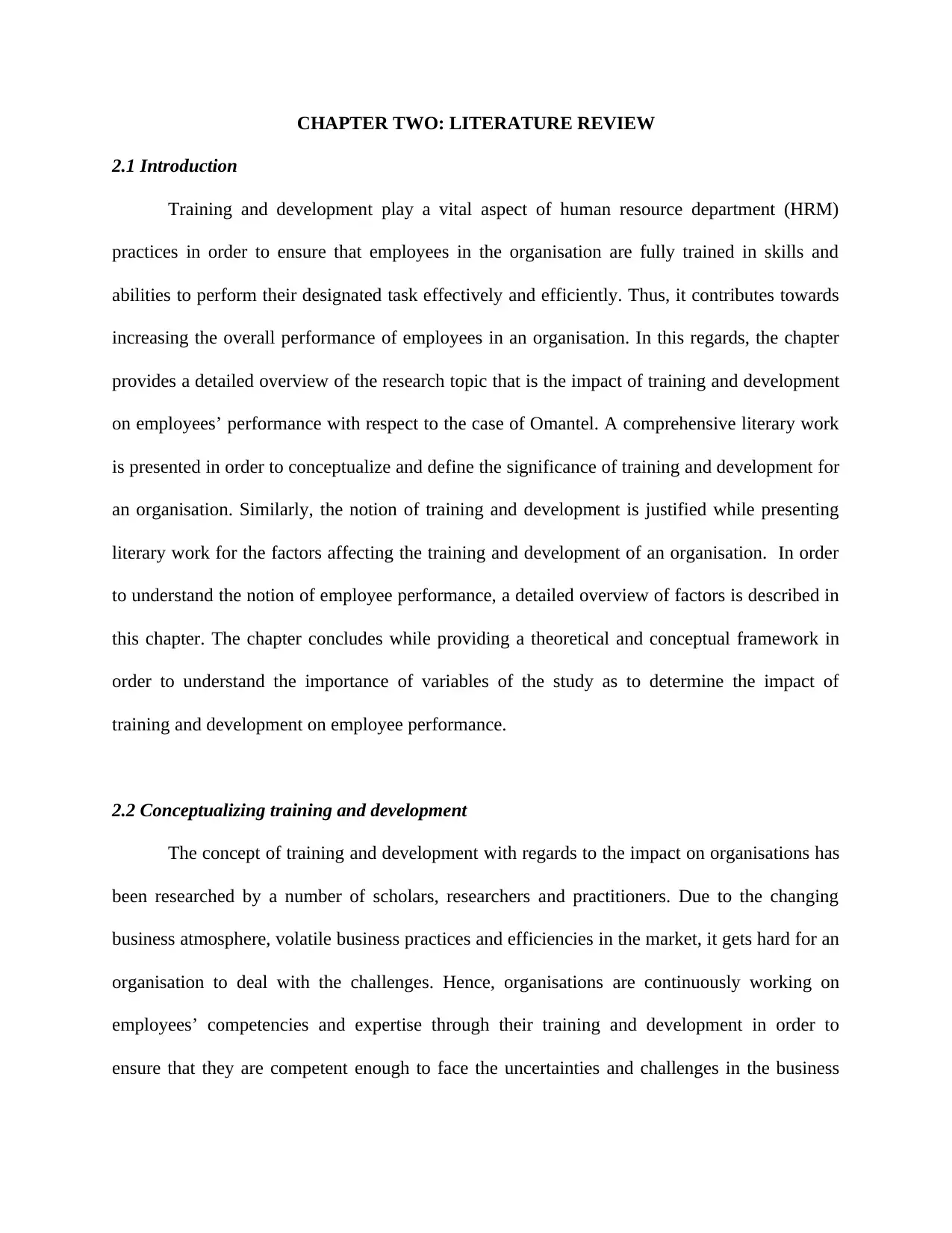
CHAPTER TWO: LITERATURE REVIEW
2.1 Introduction
Training and development play a vital aspect of human resource department (HRM)
practices in order to ensure that employees in the organisation are fully trained in skills and
abilities to perform their designated task effectively and efficiently. Thus, it contributes towards
increasing the overall performance of employees in an organisation. In this regards, the chapter
provides a detailed overview of the research topic that is the impact of training and development
on employees’ performance with respect to the case of Omantel. A comprehensive literary work
is presented in order to conceptualize and define the significance of training and development for
an organisation. Similarly, the notion of training and development is justified while presenting
literary work for the factors affecting the training and development of an organisation. In order
to understand the notion of employee performance, a detailed overview of factors is described in
this chapter. The chapter concludes while providing a theoretical and conceptual framework in
order to understand the importance of variables of the study as to determine the impact of
training and development on employee performance.
2.2 Conceptualizing training and development
The concept of training and development with regards to the impact on organisations has
been researched by a number of scholars, researchers and practitioners. Due to the changing
business atmosphere, volatile business practices and efficiencies in the market, it gets hard for an
organisation to deal with the challenges. Hence, organisations are continuously working on
employees’ competencies and expertise through their training and development in order to
ensure that they are competent enough to face the uncertainties and challenges in the business
2.1 Introduction
Training and development play a vital aspect of human resource department (HRM)
practices in order to ensure that employees in the organisation are fully trained in skills and
abilities to perform their designated task effectively and efficiently. Thus, it contributes towards
increasing the overall performance of employees in an organisation. In this regards, the chapter
provides a detailed overview of the research topic that is the impact of training and development
on employees’ performance with respect to the case of Omantel. A comprehensive literary work
is presented in order to conceptualize and define the significance of training and development for
an organisation. Similarly, the notion of training and development is justified while presenting
literary work for the factors affecting the training and development of an organisation. In order
to understand the notion of employee performance, a detailed overview of factors is described in
this chapter. The chapter concludes while providing a theoretical and conceptual framework in
order to understand the importance of variables of the study as to determine the impact of
training and development on employee performance.
2.2 Conceptualizing training and development
The concept of training and development with regards to the impact on organisations has
been researched by a number of scholars, researchers and practitioners. Due to the changing
business atmosphere, volatile business practices and efficiencies in the market, it gets hard for an
organisation to deal with the challenges. Hence, organisations are continuously working on
employees’ competencies and expertise through their training and development in order to
ensure that they are competent enough to face the uncertainties and challenges in the business
⊘ This is a preview!⊘
Do you want full access?
Subscribe today to unlock all pages.

Trusted by 1+ million students worldwide
1 out of 72
Related Documents
Your All-in-One AI-Powered Toolkit for Academic Success.
+13062052269
info@desklib.com
Available 24*7 on WhatsApp / Email
![[object Object]](/_next/static/media/star-bottom.7253800d.svg)
Unlock your academic potential
Copyright © 2020–2025 A2Z Services. All Rights Reserved. Developed and managed by ZUCOL.





